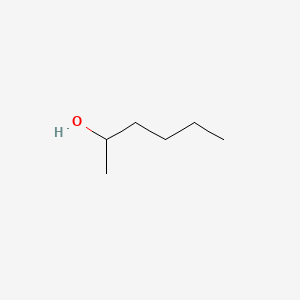| MeSH term | MeSH ID | Detail |
|---|---|---|
| Body Weight | D001835 | 333 associated lipids |
| Occupational Diseases | D009784 | 42 associated lipids |
| Peripheral Nervous System Diseases | D010523 | 33 associated lipids |
| Retrograde Degeneration | D012183 | 4 associated lipids |
2-hexanol
2-hexanol is a lipid of Fatty Acyls (FA) class. 2-hexanol often locates in Clone. The associated genes with 2-hexanol are PDC gene. The related lipids are 2-hexanol and 1-Octanol.
Cross Reference
Introduction
To understand associated biological information of 2-hexanol, we collected biological information of abnormalities, associated pathways, cellular/molecular locations, biological functions, related genes/proteins, lipids and common seen animal/experimental models with organized paragraphs from literatures.
What diseases are associated with 2-hexanol?
There are no associated biomedical information in the current reference collection.
Possible diseases from mapped MeSH terms on references
We collected disease MeSH terms mapped to the references associated with 2-hexanol
PubChem Associated disorders and diseases
What pathways are associated with 2-hexanol
There are no associated biomedical information in the current reference collection.
PubChem Biomolecular Interactions and Pathways
Link to PubChem Biomolecular Interactions and PathwaysWhat cellular locations are associated with 2-hexanol?
Visualization in cellular structure
Associated locations are in red color. Not associated locations are in black.
Related references are published most in these journals:
| Location | Cross reference | Weighted score | Related literatures |
|---|
What functions are associated with 2-hexanol?
There are no associated biomedical information in the current reference collection.
What lipids are associated with 2-hexanol?
Related references are published most in these journals:
| Lipid concept | Cross reference | Weighted score | Related literatures |
|---|
What genes are associated with 2-hexanol?
Related references are published most in these journals:
| Gene | Cross reference | Weighted score | Related literatures |
|---|
What common seen animal models are associated with 2-hexanol?
There are no associated biomedical information in the current reference collection.
NCBI Entrez Crosslinks
All references with 2-hexanol
Download all related citations| Authors | Title | Published | Journal | PubMed Link |
|---|---|---|---|---|
| pmid: | ||||
| Singh N and Dureja P | Persistence of hexaconazole, a triazole fungicide in soils. | 2000 | J Environ Sci Health B | pmid:10968606 |
| pmid:11314956 | ||||
| Kamiya S et al. | A novel series of thromboxane A2 synthetase inhibitors with free radical scavenging and anti-peroxidative activities. | 2001 | Chem. Pharm. Bull. | pmid:11383607 |
| pmid:11925192 | ||||
| pmid:12207479 | ||||
| Sakura M et al. | Olfactory discrimination of structurally similar alcohols by cockroaches. | 2002 | J. Comp. Physiol. A Neuroethol. Sens. Neural. Behav. Physiol. | pmid:12466954 |
| Pomponio R et al. | Microemulsion electrokinetic chromatography for the analysis of green tea catechins: effect of the cosurfactant on the separation selectivity. | 2003 | Electrophoresis | pmid:12761797 |
| pmid:14709084 | ||||
| Gomi K et al. | Epoxide hydrolase: a mRNA induced by the fungal pathogen Alternaria alternata on rough lemon (Citrus jambhiri Lush). | 2003 | Plant Mol. Biol. | pmid:14756316 |
| Zheng ZX et al. | Separation of enantiomers in microemulsion electrokinetic chromatography using chiral alcohols as cosurfactants. | 2004 | Electrophoresis | pmid:15472957 |
| Guerrieri F et al. | Perceptual and neural olfactory similarity in honeybees. | 2005 | PLoS Biol. | pmid:15736975 |
| Kahle KA and Foley JP | Chiral microemulsion electrokinetic chromatography with two chiral components: Improved separations via synergies between a chiral surfactant and a chiral cosurfactant. | 2006 | Electrophoresis | pmid:16470633 |
| Cui P et al. | Synthesis and biological evaluation of lisofylline (LSF) analogs as a potential treatment for Type 1 diabetes. | 2006 | Bioorg. Med. Chem. Lett. | pmid:16650991 |
| Thompson AC et al. | Identification and quantitative analysis of the volatile substances emitted by maturing cotton in the field. | 1971 | Plant Physiol. | pmid:16657733 |
| Won A et al. | Chirality in anesthesia I: minimum alveolar concentration of secondary alcohol enantiomers. | 2006 | Anesth. Analg. | pmid:16790631 |
| pmid:16790632 | ||||
| pmid:16948611 | ||||
| pmid:17075937 | ||||
| Onaca C et al. | Degradation of alkyl methyl ketones by Pseudomonas veronii MEK700. | 2007 | J. Bacteriol. | pmid:17351032 |
